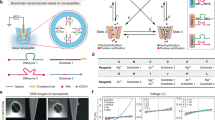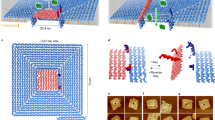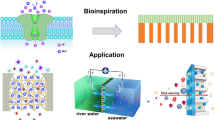Abstract
Biological nanochannels made from proteins play a central role in cellular signalling1,2,3,4,5,6,7,8,9. The rapid emergence of DNA nanotechnology in recent years10,11,12,13 has opened up the possibility of making similar nanochannels from DNA. Building on previous work on switchable DNA nanocompartment14,15, we have constructed complex DNA nanosystems to investigate the gating behaviour of these nanochannels. Here we show that DNA nanochannels can be gated by stress exerted by permeating solute particles at non-equilibrium states due to the high flexibility of the nanochannels. This novel gating mechanism results in tunable ratchet-like transport of solute particles through the nanochannels. A simple model that couples non-equilibrium channel gating with transport flux can quantitatively explain a number of the phenomena we observe. With only one set of model parameters, we can reproduce diverse gating behaviours, modulated by an inherent gating threshold. This work could lead to the development of new devices based on DNA nanochannels.
This is a preview of subscription content, access via your institution
Access options
Subscribe to this journal
Receive 12 print issues and online access
$259.00 per year
only $21.58 per issue
Buy this article
- Purchase on Springer Link
- Instant access to full article PDF
Prices may be subject to local taxes which are calculated during checkout




Similar content being viewed by others
References
Hille, B. Ion Channels of Excitable Membranes (Sinauer Associates, Sunderland, 2001).
Gillespie, P. G. & Walker, R. G. Molecular basis of mechanosensory transduction. Nature 413, 194–202 (2001).
Yellen, G. The voltage-gated potassium channels and their relatives. Nature 419, 35–42 (2002).
MacKinnon, R. Potassium channels and the atomic basis of selective ion conduction (Nobel lecture). Angew. Chem. Int. Edn 43, 4265–4277 (2004).
Perozo, E., Cortes, D. M., Sompornpisut, P., Kloda, A. & Martinac, B. Open channel structure of MscL and the gating mechanism of mechanosensitive channels. Nature 418, 942–948 (2002).
Goychuk, I. & Hänggi, P. Ion channel gating: a first-passage time analysis of the Kramers type. Proc. Natl Acad. Sci. USA 99, 3552–3556 (2002).
Wiggins, P. & Phillips, R. Analytic models for mechanotransduction: Gating a mechanosensitive channel. Proc. Natl Acad. Sci. USA 101, 4071–4076 (2004).
Markin, S. & Sachs, F. Thermodynamics of mechanosensitivity. Phys. Biol. 1, 110–124 (2004).
VanDongen, A. M. J. K channel gating by an affinity-switching selectivity filter. Proc. Natl Acad. Sci. USA 101, 3248–3252 (2004).
Seeman, N. C. DNA nanotechnology: Novel DNA constructions. Annu. Rev. Biophys. Biomol. Struct. 27, 225–248 (1998).
Seeman, N. C. DNA in a material world. Nature 421, 427–431 (2003).
Yan, H. Nucleic acid nanotechnology. Science 306, 2048–2049 (2004).
Feldkamp, U. & Niemeyer, C. M. Rational design of DNA nanoarchitectures. Angew. Chem. Int. Edn 45, 1856–1876 (2006).
Mao, Y. et al. Reversibly switchable DNA nanocompartment on surfaces. Nucleic Acids Res. 32, e144 (2004).
Mao, Y. et al. Alternating-electric-field-enhanced reversible switching of DNA nanocontainers with pH. Nucleic Acids Res. 35, e33 (2007).
Mao, Y., Luo, C. & Ouyang, Q. Studies of temperature-dependent electronic transduction on DNA hairpin loop sensor. Nucleic Acids Res. 31, e108 (2003).
Cherstvy, A. G., Kornyshev, A. A. & Leikin, S. Torsional deformation of double helix in interaction and aggregation of DNA. J. Phys. Chem. B 108, 6508–6518 (2004).
Kornyshev, A. A. & Leikin, S. Sequence recognition in the paring of DNA duplexes. Phys. Rev. Lett. 86, 3666–3669 (2001).
Wiggins, P. A. et al. High flexibility of DNA on short length scales probed by atomic force microscopy. Nature Nanotech. 1, 137–141 (2006).
Chou, T. How fast do fluids squeeze through microscopic single-file pores? Phys. Rev. Lett. 80, 85–88 (1998).
Hahn, K., Kärger, J. & Kukla, V. Single-file diffusion observation. Phys. Rev. Lett. 76, 2762–2765 (1996).
Eisenberg, R. S., Klosek, M. M. & Schuss, Z. Diffusion as a chemical reaction: Stochastic trajectories between fixed concentrations. J. Chem. Phys. 102, 1767–1780 (1995).
Nadler, B., Schuss, Z. & Singer, A. Langevin trajectories between fixed concentrations. Phys. Rev. Lett. 94, 218101 (2005).
Kosztin, I. & Schulten, K. Fluctuation-driven molecular transport through an asymmetric membrane channel. Phys. Rev. Lett. 93, 238102 (2004).
Chinappi, M. et al. Molecular dynamics simulation of ratchet motion in an asymmetric nanochannel. Phys. Rev. Lett. 97, 144509 (2006).
Siwy, Z., Fuliński, A. & Martin, C. R. Fabrication of a synthetic nanopore ion pump. Phys. Rev. Lett. 89, 198103 (2002).
Dekker, C. Solid-state nanopores. Nature Nanotech. 2, 209–215 (2007).
Chou, T. & Lohse, D. Entropy-driven pumping in zeolites and biological channels. Phys. Rev. Lett. 82, 3552–3555 (1999).
Hummer, G., Rasaiah, J. C. & Noworyta, J. P. Water conduction through the hydrophobic channel of a carbon nanotube. Nature 414, 188–190 (2001).
Hamad-Schifferli, K., Schwartz, J. J., Santos, A. T., Zhang, S. & Jacobson, J. M. Remote electronic control of DNA hybridization through inductive coupling to an attached metal nanocrystal antenna. Nature 415, 152–155 (2002).
Acknowledgements
We thank A. G. Cherstvy for a critical review and helpful comments on the manuscript. This work is partly supported by the Ministry of Science and Technology of China, and the Chinese Natural Science Foundation.
Author information
Authors and Affiliations
Contributions
Y.M. designed the experiments, established the theoretical model and performed the numerical calculations. Y.M. and S.Y. carried out the experiments. Y.M. and Q.O. analysed the data. S.C. and Y.M. performed the simulation on the mean residence number of solute particle inside channels. Y.M. wrote the manuscript, and Q.O. and L.J. proofread it. Q.O. and L.J. supervised the research project.
Corresponding authors
Ethics declarations
Competing interests
The authors declare no competing financial interests.
Supplementary information
Supplementary Information
Supplementary figures S1–S14 (PDF 1810 kb)
Rights and permissions
About this article
Cite this article
Mao, Y., Chang, S., Yang, S. et al. Tunable non-equilibrium gating of flexible DNA nanochannels in response to transport flux. Nature Nanotech 2, 366–371 (2007). https://doi.org/10.1038/nnano.2007.148
Received:
Accepted:
Published:
Issue Date:
DOI: https://doi.org/10.1038/nnano.2007.148



